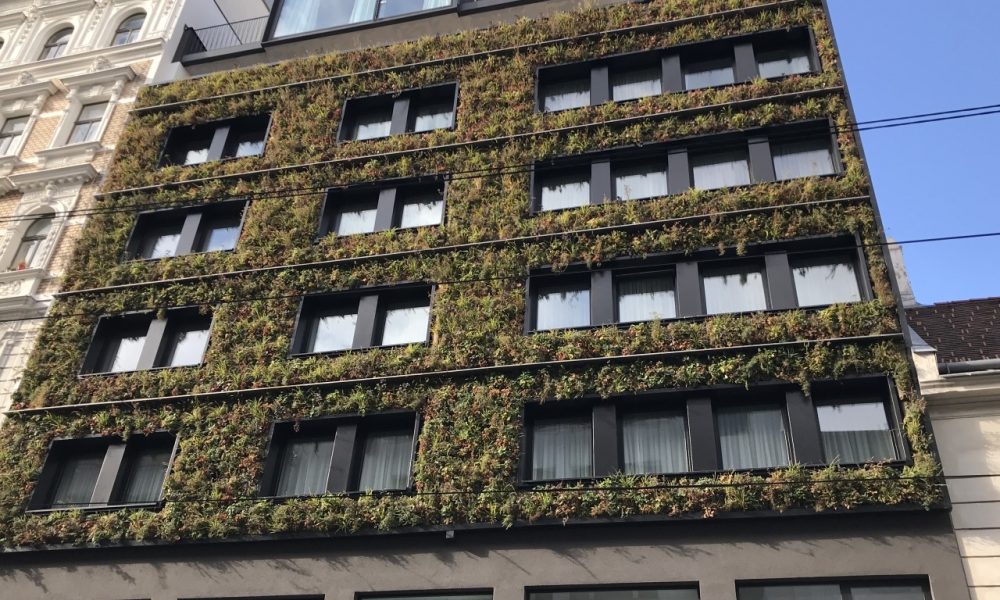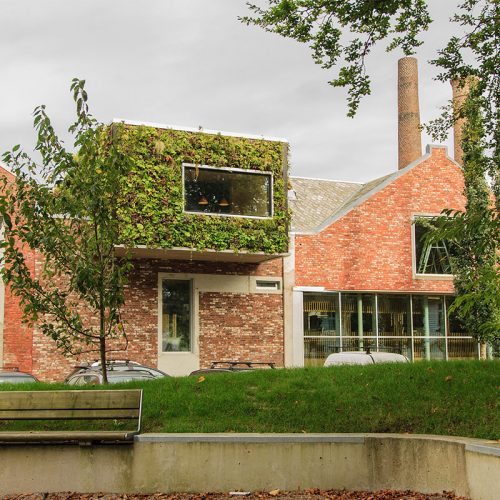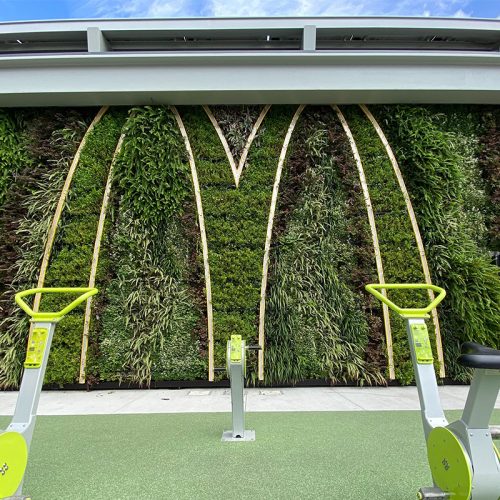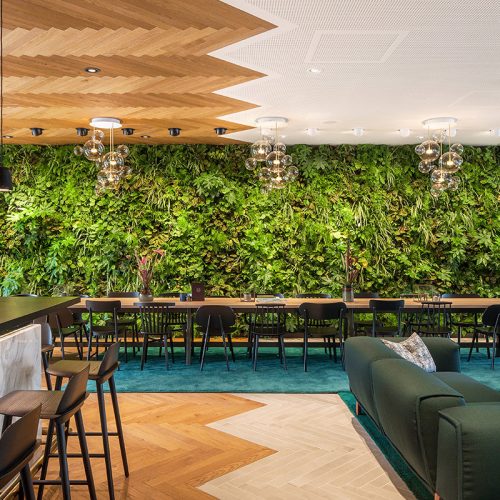Sustainable entrepreneurship is a hot topic. It’s becoming more and more common for companies to implement office design that embodies their sustainable ambitions. For example, by placing a green wall in the office, the reception or the meeting rooms. But how do you discover which green facade is the best choice for your office? If you prefer real sustainability, then you naturally opt for a living green wall. Yet there are also companies that go for a wall with fake plants. The appearance may look green, but does it provide the same health benefits? Which is the best choice? In this article we compare the advantages and disadvantages of a green wall with living plants and those of an artificial green wall.
Why go green in the workplace?
Scientists are unanimous: green has a calming effect on people 1. In addition, having a green view from the workplace is associated with a reduction in people’s stress level and an improvement in concentration 2. An additional benefit is the increased employee productivity, which tends to be even 15% higher than in office spaces without plants 3. Plants create a pleasant atmosphere 4, which leads to increased satisfaction with one’s own workplace 5. And this in turn ensures that people get more work done. Here’s another important argument: green brings people together. People like to visit each other in a green environment. A green wall can therefore function well as a meeting place within an organization. The arguments in favour of green are evident. However, if you intend to introduce greenery in the workplace, you are faced with the choice between real and artificial plants.
Want to know why employees brighten up when there are real plants in the office? Read more in this blog.
What are the advantages of real plants compared to artificial plants?
The possibilities with real plants are endless. Real plants can be used in any room, because living walls are equipped with special plant lighting. The choice of plants is also virtually unlimited. You can often choose from a standard plant range, but if you prefer just that one special favourite plant in your green wall, it is often also possible. Below we list the most important benefits of real greenery.
- Health benefits of real plants in the office
Real plants are healthy. They release oxygen into the air, remove CO2 from the air and lower the concentration of harmful substances. Plants evaporate moisture, which benefits the humidity. An important positive consequence of this is that employees experience fewer health problems, like headaches, irritated eyes, dry throat and fatigue. Plants also absorb sound in the room, which reduces noise pollution and nuisance6. This has a positive effect on employee absenteeism and makes employees feel more comfortable in the workplace.
- Sustainable benefits of real plants in the office
In addition to the health benefits, there are also many sustainable benefits of choosing living greenery in the office. Plants are naturally UV resistant. Pre-treatment of the plants to withstand the influence of sunlight is not necessary. This makes real plants very durable. Some living wall systems even have been thoroughly assessed and certified with a sustainability label, such as the SemperGreenwall. This green wall system is provided with the Cradle-to-Cradle sustainability label. This also means that all components of the green facade system can be fully recycled.
Furthermore, living plants naturally contain 90% water. Thanks to this composition, plants do not ignite quickly and burn poorly, so they are fire retardant by nature. The Flexipanel, the building block of the living wall system SemperGreenwall, even has been granted the European fire classifications A2-s2,d0 and B-s2,d0, which is unique in the world. Thanks to the A2 certification, the SemperGreenwall system can be used, for example, in high-rise projects or other projects with very strict fire safety requirements.
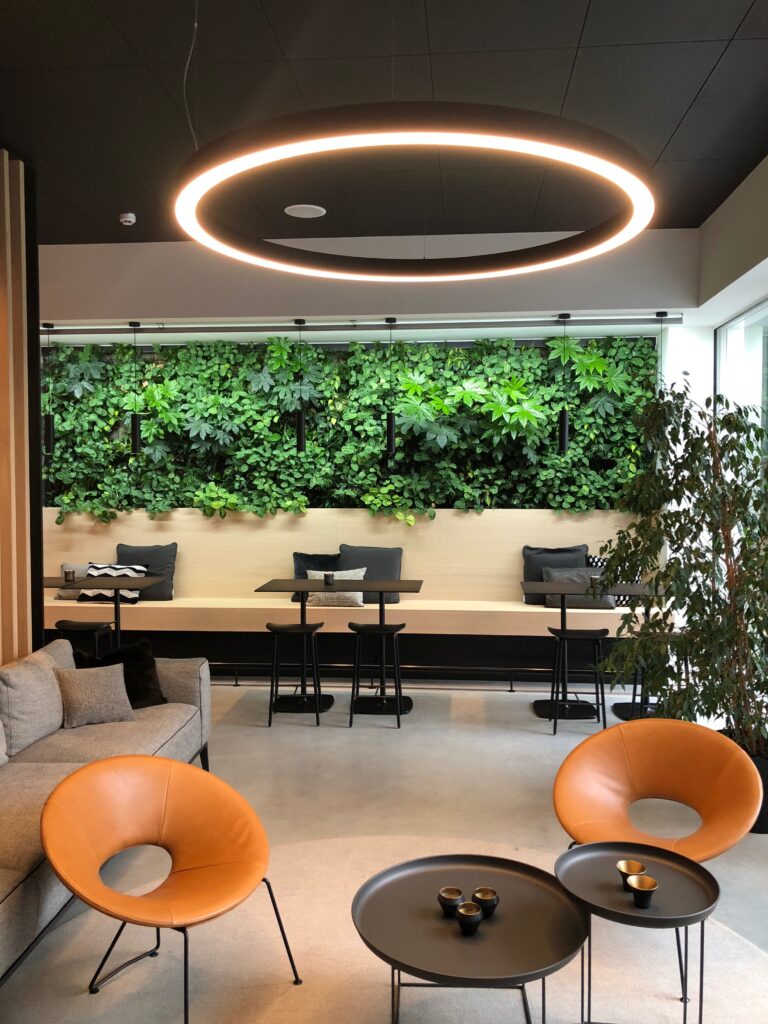
- Financial benefits of real plants in the office
Real plants have a heat-regulating effect. Applying a substantial number of plants in the workspace improves thermal comfort 7. By decreasing the ambient temperature, the energy costs for cooling and production loss are reduced 8. If you include a maintenance contract, all service is taken care of and the annual costs for plant care are transparent in advance. Another important financial argument is that sustainable greenery in or on a building increases the sales value of the building. In various countries, it’s also possible to receive financial incentives like subsidies for the installation of a living wall, which lowers the cost.
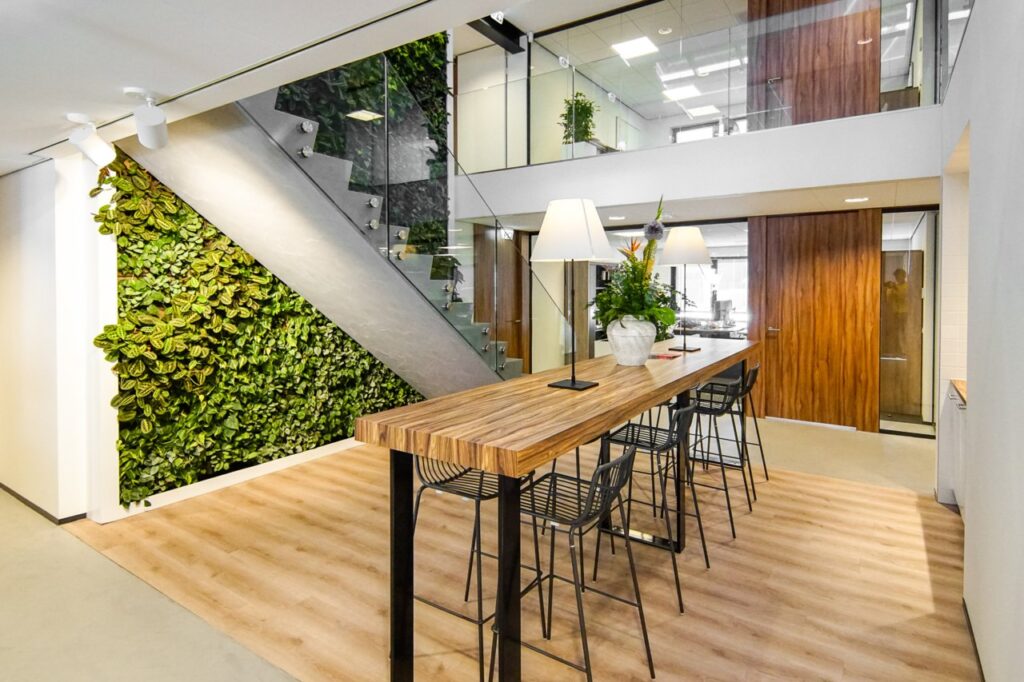
Are there also advantages of artificial plants compared to real plants?
Artificial greenery resembles real plants but is made of plastic and artificial silk. Artificial plants have the advantage of low maintenance costs. In addition, artificial plants do not require daylight, which means that installation in dark places is also possible without additional lighting. An artificial green wall can also often be recycled and is available in many sizes and models to fit in places with limited space. Moreover, artificial plants are UV-resistant, and the wall can be made fire-retardant by impregnating the artificial plants with a fire-retardant coating. The appearance is guaranteed to remain the same in the long term. There is also no chance of plant diseases or insects.
How do the disadvantages relate to each other?
To quote the world-famous footballer Cruyff: “Every advantage has its disadvantage.” Of course, this also applies to the options mentioned. We list them below:
- What are the disadvantages of real plants?
Living plants require care. To ensure that you do not have to worry about this, there is the possibility of using a service contact like we offer for the SemperGreenwall. A living wall with real plants also needs a little more space to accommodate a water and nutrient tank. Finally, if you have special plant preferences and wishes, there may be a longer delivery time, for example if a green wall must be specially cultivated.
- What are the disadvantages of artificial greenery?
The biggest disadvantage of artificial greenery is that it is not sustainable and environmentally friendly. Plastic and artificial silk are used to produce the plants. Paint is used to create the plant colours. Although artificial plants look more and more natural, they still have a different appearance from living plants; real plant lovers recognize artificial plants from afar. This can have a negative effect on a company’s sustainability goals and the sustainable values they want to show. Finally, artificial plants catch a lot of dust and must therefore be cleaned. The investment in time and costs for this is sometimes overlooked when choosing artificial plants.

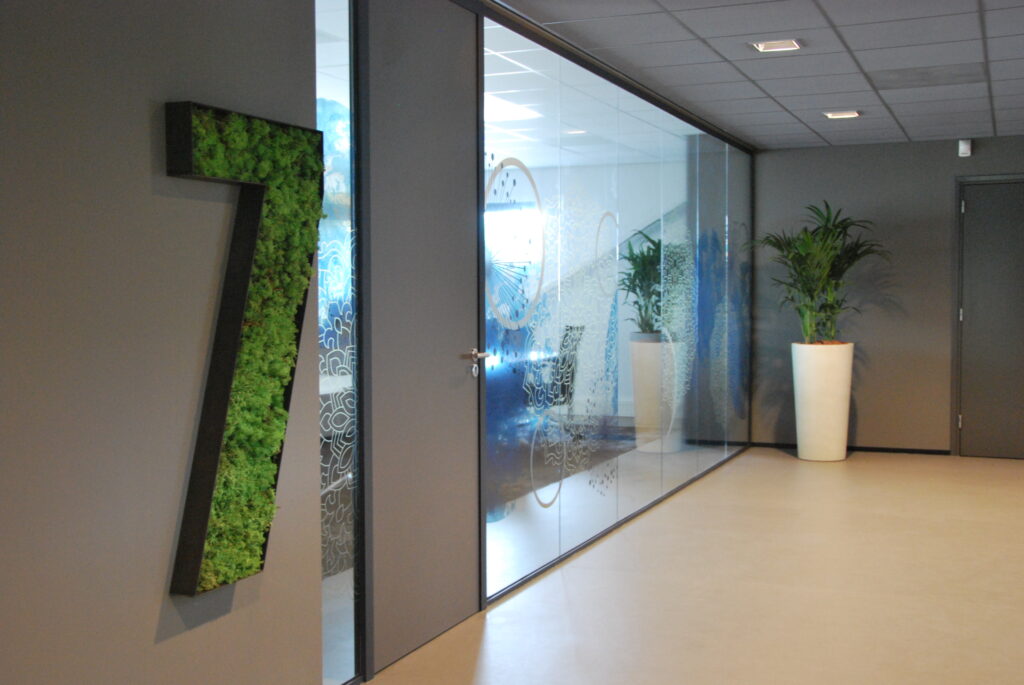
But what about a moss wall?
We often get the question: “What about a moss wall, isn’t it alive?”. The moss wall forms a gray area within the range of green walls. Moss is not artificial; it is a plant that comes from nature. But before moss ends up on a green facade, it has undergone a complete pre-treatment with preparation liquid and paint. In addition, the moss is treated with natural salts, which is detrimental to biodiversity. By the time the moss is on the wall, it is no longer alive. This is also apparent from the fact that a moss wall does not require light, water or maintenance. In fact, the moss does not tolerate direct sunlight well, because the dyes on the moss will discolour.
Are there no advantages to a moss wall?
Of course, choosing a moss wall offers a few advantages. For example, the wall is maintenance-friendly, dust-resistant, fire-retardant, sound-absorbing and it looks great as an artistic addition to the interior, for example in the form of a painting. Just keep in mind that a moss wall is sensitive to changes in the humidity of a room. Fluctuations in the atmosphere can damage the moss or dry out and crumble when touched. This does not benefit the appearance of the wall. And here again the main argument is that a moss wall does not contribute to healthy air quality, real plants do. And then you miss out on an important advantage of a green wall in your office.
Which green wall do you choose?
Real plants in the office offer many advantages over artificial plants. Especially in the field of air quality, thermal comfort, employee satisfaction and productivity as well as the reduction of employee absenteeism due to illness, a living wall wins out over the artificial variant. The biggest advantage of an artificial green wall is the lower maintenance costs. On the other hand, the cost reduction due to decreasing absenteeism thanks to the use of real plants could even out with maintenance costs. Moreover, a wall with artificial plants can have the opposite effect on the sustainable image that a company wants to radiate to the outside world. True lovers of greenery will recognize an artificial plant from afar. You may also recognize yourself in the fact that you tend to feel a plant to see if it is real. Many people have this habit. If the plant turns out to be fake, this often is a turn-off. In short: make your employees happy with a truly green wall. Because people are keen on green!
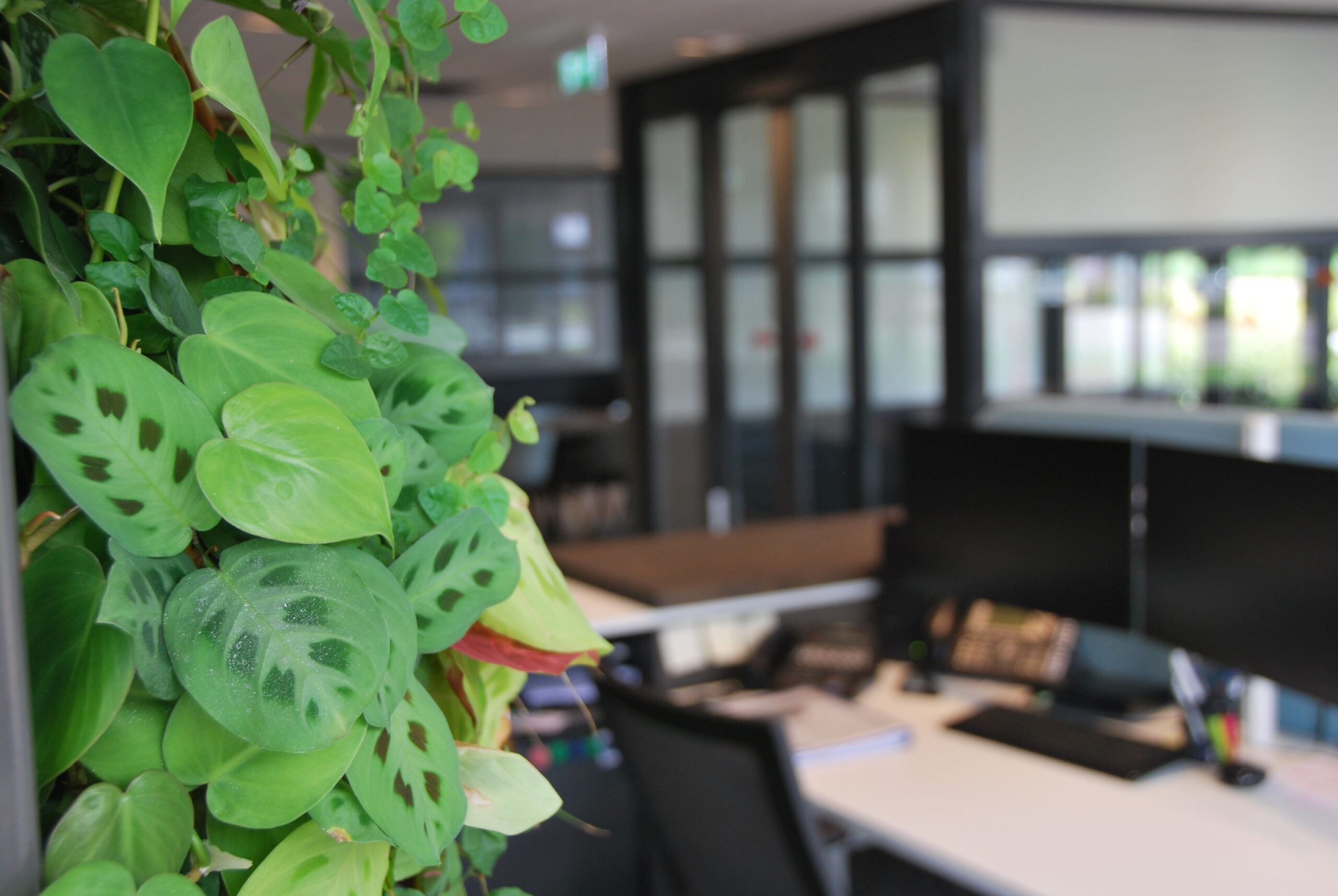
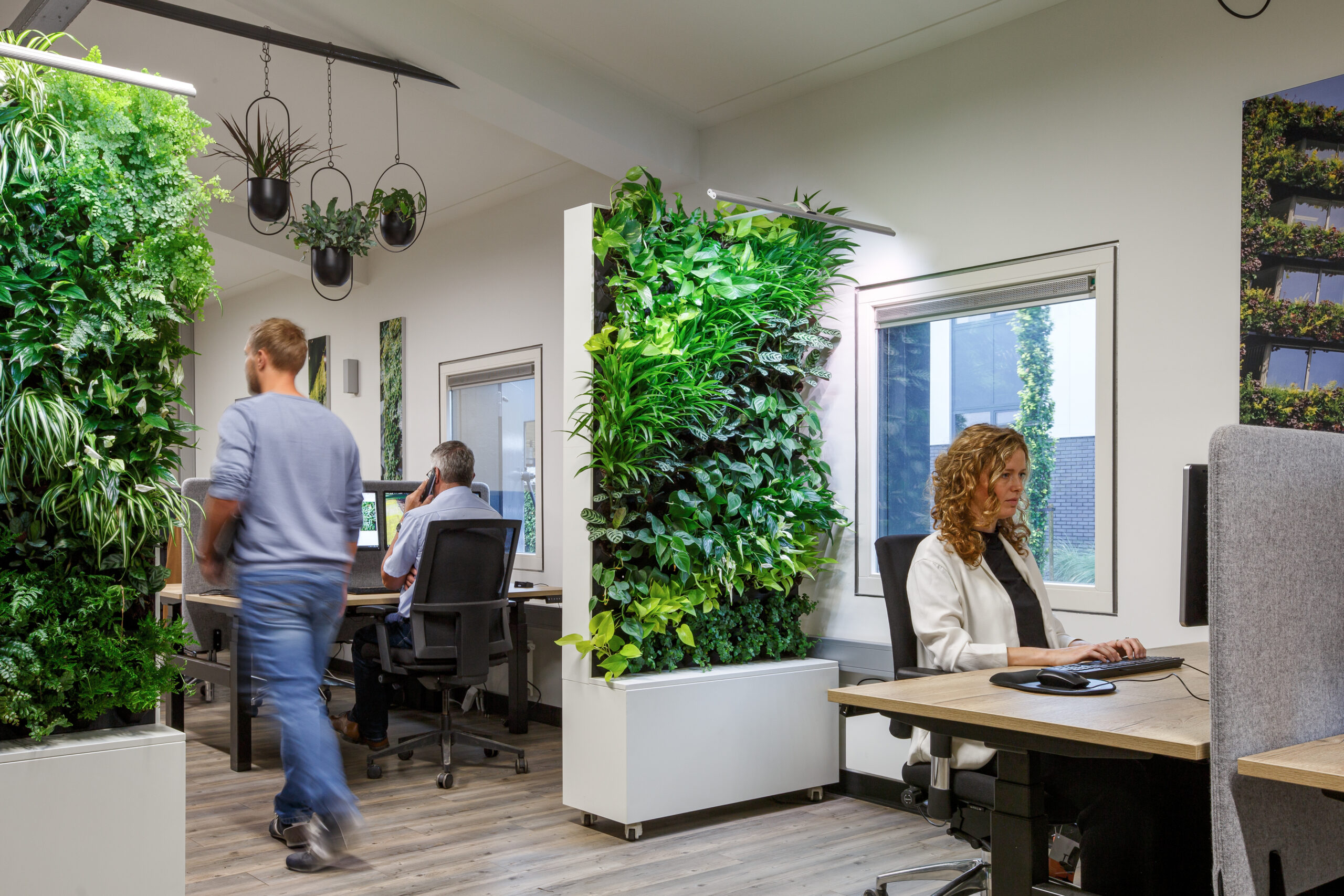
More information and inspiration about living walls?
Would you like to know more about the advantages of a green wall with real plants? Look at this page. Or view these wonderful reference projects to get an idea of what a living wall can look like in the workplace. Would you like to be advised about your office space? Please contact one of our green wall consultants. They are happy to help you.
Sources
- In a Norwegian study, office workers without a view to the outside from their workplace were five times more likely to bring a plant to their workplace than those with a view. Source: T. Bringslimark, T. Hartig & G.G. Patil (2011), Adaptation to windowlessness: Do office workers compensate for a lack of visual access to the outdoors? Environment and behavior:0013916510368351.
- Smith, M. Tucker & M. Pitt (2011), Healthy, productive workplaces: Towards a case for interior plantscaping. Facilities 29(5-6):209-223. R.K. Raanaas, K.H. Evensen, D. Rich, G. Sjøstrøm & G. Patil (2011), Benefits of indoor plants on attention capacity in an office setting. Journal of Environmental Psychology 31(1):99-105.
- Nieuwenhuis, C. Knight, T. Postmes & S. Haslam (2014), The relative benefits of green versus lean office space: Three field experiments. Journal of Experimental Psychology: Applied 20(3):199-214.
- Klein Hesselink, J. et al. 2006. Fysiologische en psychische effecten van planten in de werksituatie op de gezondheid en het welbevinden van werknemers. Literatuurstudie. TNO-rapport 21573/018.10311, Hoofddorp
- Dravigne, T.M. Waliczek, R.D. Lineberger & J.M. Zajicek (2008), The effect of live plants and window views of green spaces on employee perceptions of job satisfaction. HortScience 43(1):183-187.
- Costa, P. en James R.W. 1995, Constructive use of plants in office buildings. Lecture notes for the catalogue of the symposium ‘Plants for People’. The Hague, The Netherlands
- Mangone, S.R. Kurvers & P.G. Luscuere (2014), Constructing thermal comfort: Investigating the effect of vegetation on indoor thermal comfort through a four-season thermal comfort QuasiExperiment. Building and Environment 81:410-426.
- E.C.M. Hop & J.A. Hiemstra (2013), Ecosysteemdiensten van groene daken en gevels. Een literatuurstudie naar diensten op het niveau van wijk en stad. Wageningen UR – PPO.
